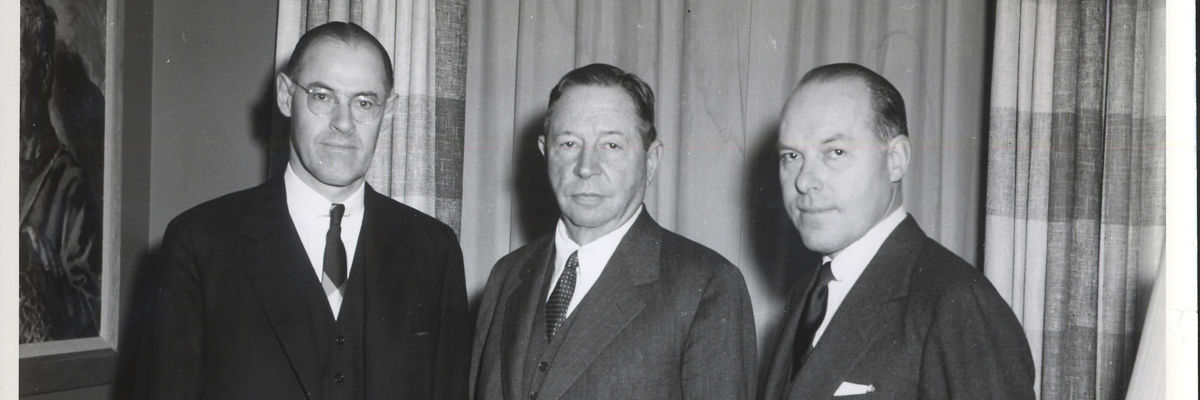
A Prudent Voice: Dwight Robinson
In 1959, Time magazine sent reporters to interview MFS® chair Dwight Robinson on the research, risk management and commitment to large and small investors that set Massachusetts Investors Trust, MFS’ first fund, apart from other mutual funds in the industry.
Following World War II, mutual funds were relatively unfamiliar to many middle-class investors,1 but that began changing in the 1950s. Personal savings were inching upward and interest in the stock market was growing.2 Mutual funds were witnessing a surge in popularity — especially MFS’ first fund, Massachusetts Investors Trust (MIT). In 1959, MIT was the largest mutual fund in the United States,3 with some 203,000 shareholders and $1.5 billion in assets under management,4 and MIT’s success caught the attention of Time magazine.
Time sent reporters to interview Dwight P. Robinson, Jr., who was the firm’s chair at the time.5 Robinson began his tenure at the firm in 1932 when he became not only the firm’s first director of research but the industry’s as well. He went on to become chair in 1954 and served until 1965.6
The reporters shadowed him over a few days, seeing how he exhibited every trait one could ever want in an investment manager. He was calm and confident but also disciplined and exacting. He ran his life, as Time noted, “on a pre-arranged schedule as exact as a balance sheet.”7
When it came to the investment world, Robinson explained that “Investment is not a science. It is a matter of human judgment” based upon collecting and studying facts.8,9 Robinson walked factory floors, asked pointed questions of management and also made sure to talk to regular employees about the inner workings of their employers and the company.10 “Trust and verify” was what Robinson told his research team, directing them to trust their research but verify it with their own eyes and ears, so the firm could make better and more informed investment decisions.11 He assigned certain analysts to follow individual industries and sectors and asked all MFS analysts to regularly present their findings to the fund trustees and advisors.12,13 Because of the depth of MFS’ proprietary research, MIT shareholders knew their money was being managed with care and discipline.14

He insisted that mutual funds were built to address the long-term needs of all investors, large and small, and he spoke passionately about past achievements, commitment to risk management and pursuit of long-term gains on behalf of clients.

As mild-mannered as Robinson might have appeared, there was something powerful about the way he spoke, especially about protecting other people’s money. He insisted that mutual funds were built to address the long-term needs of all investors, large and small, and he spoke passionately about past achievements, commitment to risk management and pursuit of long-term gains on behalf of clients.
After spending so much time with Robinson, Time’s reporters came to the following conclusion in their 1959 article titled “The Prudent Man”: “The fund that has done more than any other to put shares in the household sugar bowl is Massachusetts Investors Trust, oldest and biggest of the mutual funds and the one that set the pattern for all the rest.”15,16
Shortly after the piece was published, a flood of letters from around the world poured into both Time’s and MFS’ offices.17 One mutual fund salesman called the story the “quickest and best explanation of what mutual funds are about.”18 A couple from Connecticut were so taken with Robinson’s portrayal of MFS that they enclosed a $50 check to purchase shares of MIT.19 One of the most heart-warming responses to the article came from a Missouri librarian, one of the small everyday investors that the firm sought to champion. She summed up Robinson’s legacy by writing “Somehow the story in Time made me glad I am an American and live in a country where I can write a letter to a busy executive and be certain that he cares about the trust of little people.”20
It is because of Robinson’s profound influence throughout his more than 30 years at MFS that the crucial importance of knowing what the firm owns for its clients through “bottom-up fundamental research” and “kicking the tires on a potential investment” has become so integral to MFS’ makeup today.21
Please note: Not all of the funds included in this material may be available for sale in your country.
Endnotes
2 Personal Saving, 1950-2020 (6 April 2021). Peter G. Peterson Foundation. https://www.pgpf.org/chart-archive/0063_personal-savings.
3 The Prudent Man. Time Magazine.
4 The Prudent Man. Time Magazine.
5 The Prudent Man. Time Magazine.
6 Harvard Professorship Honors Former MFS Chairman (October 1994). The Reporter. MFS Employee Magazine. Page 3.
8 The Prudent Man. Time Magazine.
9 The Prudent Man. Time Magazine.
10 Dwight Robinson, retired chairman of Mass. Investors Trust fund; at 89 (July 15, 1989). The Boston Globe. Page 17.
11 Henderson B. and Ward, S. (January 10, 2000). All-Stars: A look at the fund world’s heaviest hitters. Barron’s. Page 80.
12 Henderson and Ward, page 80.
13 Henderson and Ward, page 80.
14 Griffeth, B. (1995). The Mutual Fund Masters. Probus Publishing.
15 The Prudent Man. Time Magazine
21 Earle-Levine, J. (Jun 24, 2003). Valuing Friends in High Places. The Financial Times. London.